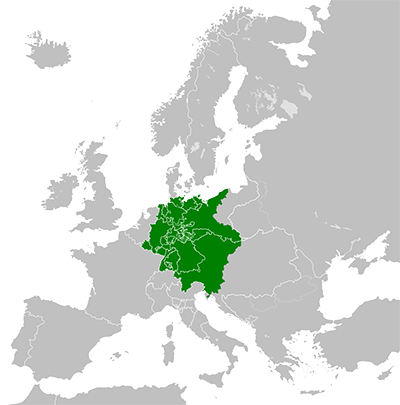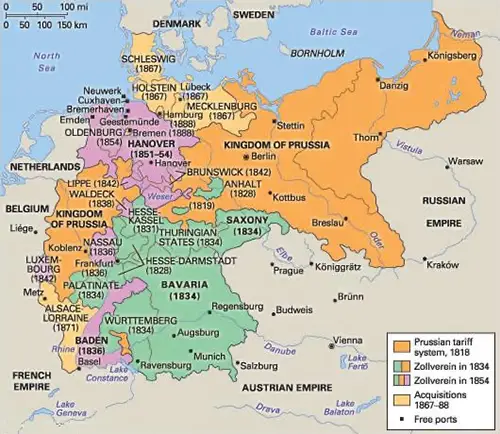Zollverein: Germany's 19th-Century Economic Union
The Zollverein was an economic union of an increasing number of German states in the 19th Century, laying the foundation for the later unification of Germany. Rulers of what is now Germany had been part of the Holy Roman Empire for centuries, with the title of those leaders varying between King of Germany and King of the Romans (both being effectively the same thing). The last ruler of the Holy Roman Empire and its hundreds of subservient states was Francis II, who abdicated after the defeat of imperial forces to France at the Battle of Austerlitz in 1806. French Emperor Napoleon Bonaparte replaced the Empire with the Confederation of the Rhine, which comprised 35 former German states and was in existence for seven years. Significantly, not joining the Confederation were Austria and Prussia, both of whom fought on against France. After the Allied victory at Leipzig in 1813, many of those former German states joined the Sixth Coalition, declaring war on France. The Allies dissolved the Confederation on Nov. 4, 1813. 
The Congress of Vienna in 1815 created the German Confederation, a new grouping of 40 states that included the Austrian Empire and the Kingdom of Prussia, both of which were large and powerful. The German Confederation was set up with the idea that the stronger states would dominate. The Federal Assembly, known as the Confederate Diet, met in Frankfurt and was nominally in charge of what government there was; presiding over the Assembly was a delegate from Austria, who was head of state in all but name. The Confederation presented political unity, but the many moving parts were still disparate economically. Such matters were considered too contentious for the immediate discussions. Prussia filled this void to a certain extent in 1818 by creating an internal customs union, which included Prussia proper and a handful of territories in what is now southwestern Germany. The following year, the state of Baden proposed a Confederation-wide customs union; the Diet refused. Beginning later that year and continuing for the next decade, more and more German states joined the Prussian customs union. The idea was to eliminate tariffs and other barriers to trade and commerce, with the hope of increasing common prosperity. As other European powers struggled through various economic problems of their own in the early 19th Century and, in some cases, strongly discouraged foreign imports, the German states found it more and more reasonable to embrace commonality rather than competition. It wasn't just Prussia and its allies that were pursuing such a common course. Württemberg sought such an agreement with first Baden and then Bavaria, the latter producing the South German Customs Union in 1825. Elsewhere, Hanover, Hesse, and Saxony engaged in their own form of economic commonality. In 1828, Prussia and its customs union partners welcomed the Grand Duchy of Hesse into the fold. In that same year, the Treaty of Kassel provided for the Central German Union, an association of 17 northern and central German states large and small. The two unions joined in 1829. 
The number of states in the customs union continued to grow. Final amalgamation into the Zollverein occurred in 1834 as the result of a series of treaties. A move to standardize currency conversion followed two years later, as more and more states joined. The at times violent Revolutions of 1848 ushered in a new era of liberalism and national identity. The response within Prussia was determined and heavy-handed; the response in other German states varied. Among the ideas bandied about, however, was the idea of a union that covered both political and economic bases. The revolutions ended, and the states of Europe moved onward. During next decade, a couple more German states joined the Zollverein. In 1857, representatives of the customs union signed a treaty with Austria and Liechtenstein, bringing about standardization of currencies between the three entities. The promise of the joint understanding went unrealized, as events in Europe made it unworkable. For starters, the standardization was based on the silver standard, in opposition to most other European powers, which relied on the gold standard. As well, wars got in the way, with Austria going to war with Italy in 1859 and then with Prussia in 1866. The three-party monetary union fell apart after that. As a result of that war, Prussia gained the duchies of Holstein and Schleswig, both of which found their way into the Zollverein in 1868. Another piece of the puzzle, Alsace-Lorraine, joined in 1871, after the Prussian rout of France. The formation of the German Empire in that same year solidified the customs union as a form of economic unity within that empire and, many suggest, the direct progenitor of it. Other entities took a while to get on board. Bremen and Hamburg, for example, joined only in 1888. The end of the Zollverein came in 1919, along with the end of the German Empire–both replaced by the Weimar Republic. |
|
Social Studies for Kids
copyright 2002–2025
David White




